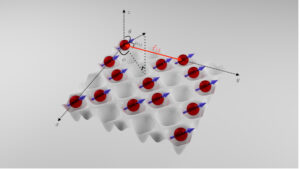Supersolid phases with lattice dipolar bosons

Supersolidity is a fascinating state of matter in which crystalline order and global phase coherence are simultaneously present. Ultracold quantum gases offer a highly controllable platform where experimental efforts for the realization of this state of matter have focused. For example, dipolar interactions have been shown to be responsible for a spontaneous formation of droplets of gas organized in a crystalline structure.
We have studied under which experimental conditions dipolar bosons trapped in a square optical lattice can stabilize a variety of supersolid phases. In the systems studied, dipoles are parallel to each other. Depending on the direction of the dipoles, various types of supersolids (e.g. checkerboard, stripe) and solids (checkerboard, stripe, diagonal stripe, and an incompressible phase) can be stabilized. We have found a cluster supersolid characterized by the formation of horizontal clusters of particles. These clusters order along a direction at an angle with the horizontal. Moreover, we have found what we call a grain-boundary superfluid. In this phase, regions with solid order are separated by extended defects — grain boundaries — which support superfluidity. Below, we show the phase diagrams for three different choices of the polarization angle.
In the picture above, the x-axis is the filling factor n and the y-axis is the dipolar interaction strength $\gamma$. For polar angles $\theta\lesssim \frac{\pi}{6}$, the solid phase stabilized at half filling is a checkerboard solid (CB) and the supersolid phase is a checkerboard supersolid (CBSS); for $\theta\gtrsim \frac{\pi}{6}$, the half filling solid phase is a stripe solid (SS) and the supersolid phase around half filling is a stripe supersolid SSS. In (b), CSS stands for cluster supersolid, IP stands for the incompressible ground states stabilized at rational filling factors, CIP is a cluster incompressible phase (see text for more details), GBSF is a grain-boundary superfluid, and MS is a metastable region. Dark blue regions in (b) and (c) correspond to first-order phase transitions. Dotted lines at filling factor $n=0.5$ represent solid phases CB or SS.
In the picture below we show the particle distribution in the lattice for some of the phases found. Here, each circle corresponds to a single lattice site, and its radius is proportional to the local density.
(a) is an example of incompressible phase where the space between filled rows can be irregular; (b) is an example of the cluster solid; (c) is an example of the grain-boundary superfluid; (d) shows phase coexistence of vacuum and superfluid regions across a first order phase transition.
To learn more, see:
PRA or https://arxiv.org/pdf/2301.00099.pdf
PRA or https://arxiv.org/pdf/2201.03756.pdf
PRA or https://arxiv.org/pdf/2010.13673.pdf
Other relevant publications:
Equilibrium phases of tilted dipolar lattice bosons or on arXiv
Quantum phases of dipolar soft-core bosons or on arXiv
Quantum phases of dipolar bosons in bilayer geometry or on arXiv
Solid phases and pairing in a mixture of polar molecules and atoms or on arXiv
Quantum Phases of Cold Polar Molecules in 2D Optical Lattices or on arXiv

